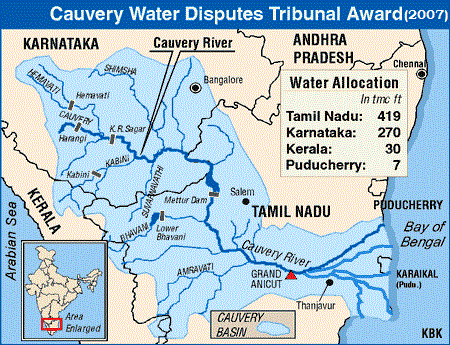Why in news?
The Supreme Court has pronounced its verdict on the sharing of Cauvery water among Tamil Nadu, Puducherry, Karnataka and Kerala.
How did the Cauvery dispute emerge?
- Historically, Tamil Nadu used about 602 TMC of the total yield of the river i.e. the available water in a particular year.
- As a result, only about 138 TMC was available for Karnataka until the turn of the 20th century.
- In 1924, Tamil Nadu built the Mettur dam across the Cauvery river.
- Subsequently, Karnataka and Tamil Nadu signed an agreement effective for 50 years.
- Accordingly, Tamil Nadu was allowed to expand its agricultural area by 11 lakh acres from the existing 16 lakh acres.
- Karnataka was authorised to increase its irrigation area from 3 lakh acres to 10 lakh acres.

- The Cauvery River thus primarily served the needs of farmers in Tamil Nadu.
- On completing 50 years, the accord lapsed in 1974.
- Subsequently, Karnataka claimed that the agreement restricted its ability to develop farming activities along the Cauvery basin.
- To make up the lost ground, Karnataka attempted to expand farming activities in the Cauvery basin.
- It started building reservoirs.
- With this, the Cauvery river water sharing issue emerged.
- It is now a major water sharing dispute among Tamil Nadu, Karnataka, Puducherry and Kerala.
- Tribunal - By Tamil Nadu's demand, the Union government formed the Cauvery Water Disputes Tribunal (CWDT) in 1990.
- The dispute was adjudicated by the CWDT in 2007.
What was the Tribunal's order?
- According to the tribunal's order, the total availability of water in the 802-km long Cauvery basin is 740 tmc in a normal year.
- Of the total 740 thousand million cubic feet (TMC) of water available for utilisation -
- 419 TMC was awarded to Tamil Nadu
- 270 TMC to Karnataka
- 30 TMC to Kerala
- 7 TMC to Puducherry
- The remaining 14 TMC was reserved for environmental protection.
- To acheive this sharing, the order stated that Karnataka must release 192 TMC of water from Biligundlu Station (inter-state dam) in normal monsoon years.
- This should be at the rates specified by the tribunal for each month.
- The tribunal also noted that in case the yield was less in a distress year, the allocated shares shall be proportionately reduced.
What was the response?
- Both Tamil Nadu and Karnataka challenged the tribunal’s order.
- Karnataka claimed 312 TMC of water as against the 270 TMC ordered by the tribunal.
- The court reserved its order in September 2017.
What is the present SC verdict?
- The Court declared Cauvery a “national asset”.
- It upheld the principle of equitable apportionment of inter-State river water among riparian States.
- The judgment concluded that the CWDT did not take into account Tamil Nadu's stock of an “empirical” 20 TMC of ground water.
- Accordingly, Karnataka is "entitled to marginal relief".
- In its present verdict, the Supreme Court has thus reduced the allocation of Cauvery water from Karnataka to Tamil Nadu.

- This means a reduction of 14.75 TMC quota of Cauvery water to Tamil Nadu from the earlier 192 TMC as stipulated by the tribunal.
- This change will be adjusted from the Biligundlu site.
- Karnataka will now release only 177.25 TMC Cauvery water from Billigundlu site to Mettur dam in Tamil Nadu.
- The SC has given the Centre 6 weeks to frame a scheme to make sure the final decisions are implemented.
- SC has also directed the formation of the Cauvery Management Board (CMB) immediately.
CMB will be an inter-state forum which will work to ensure the implementation of orders of the CWDT.
The Board shall be under the control of the Ministry of Water Resources.
The members of the Board will include a Chairman, two full-time members, and representatives of the central government and each of the four states.
The expenses of the Board will be borne by the state governments.

